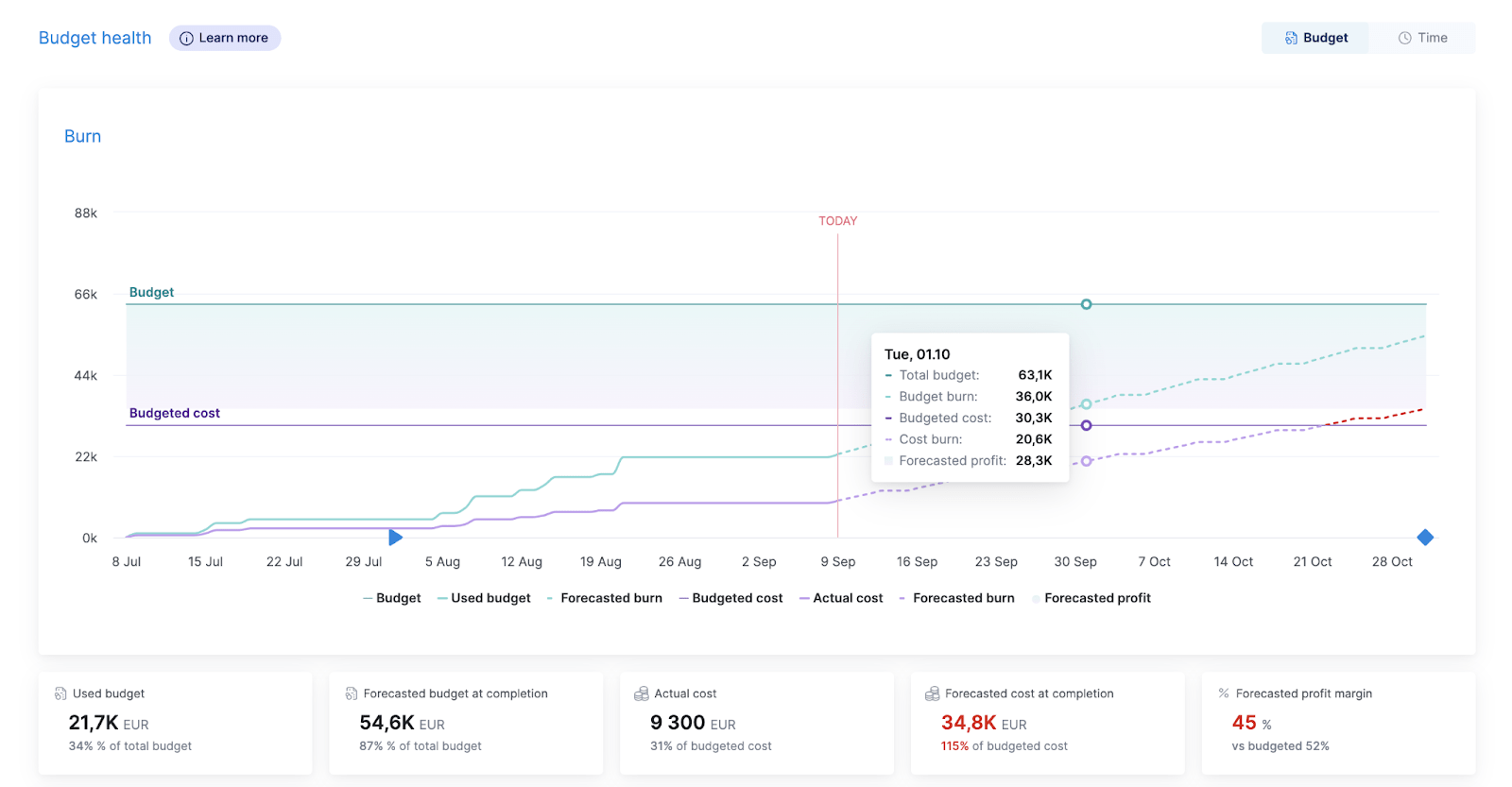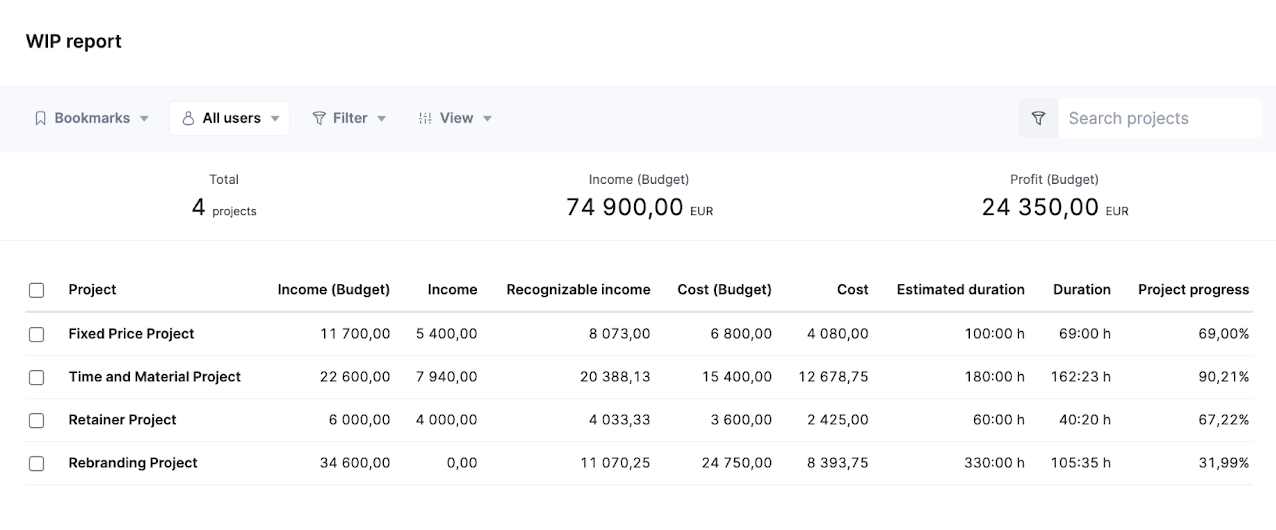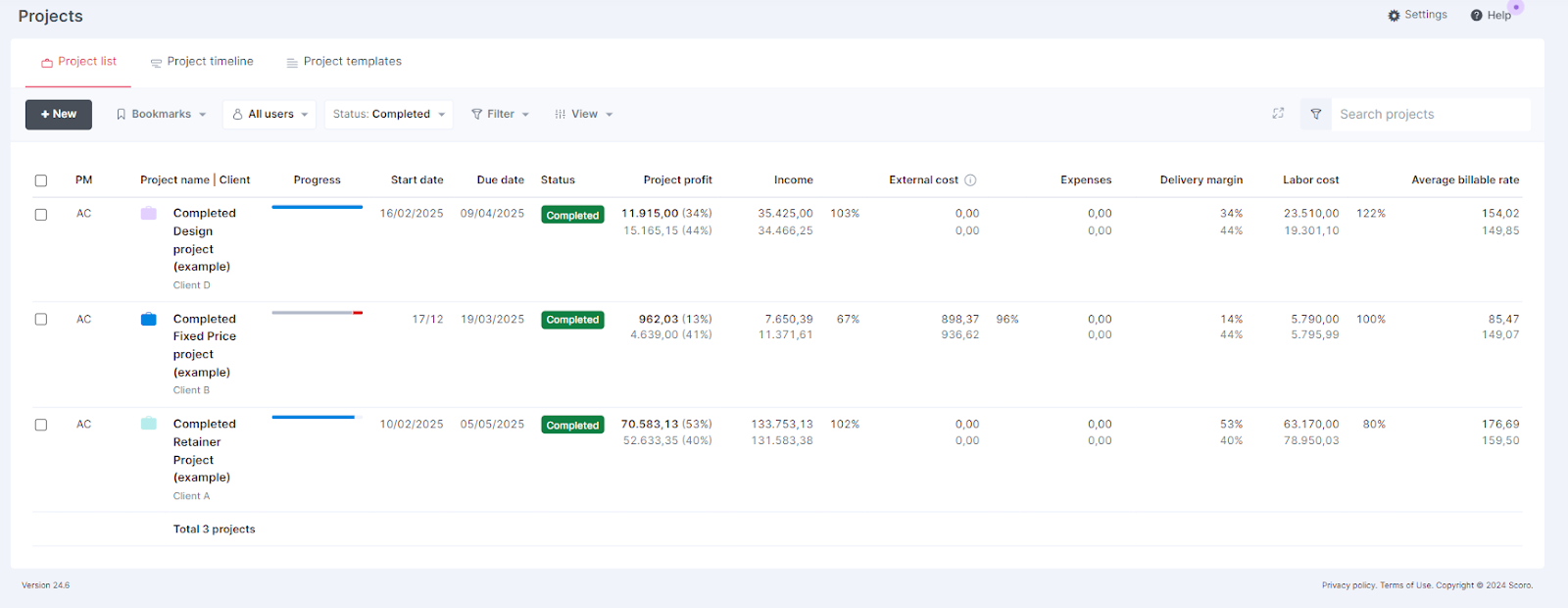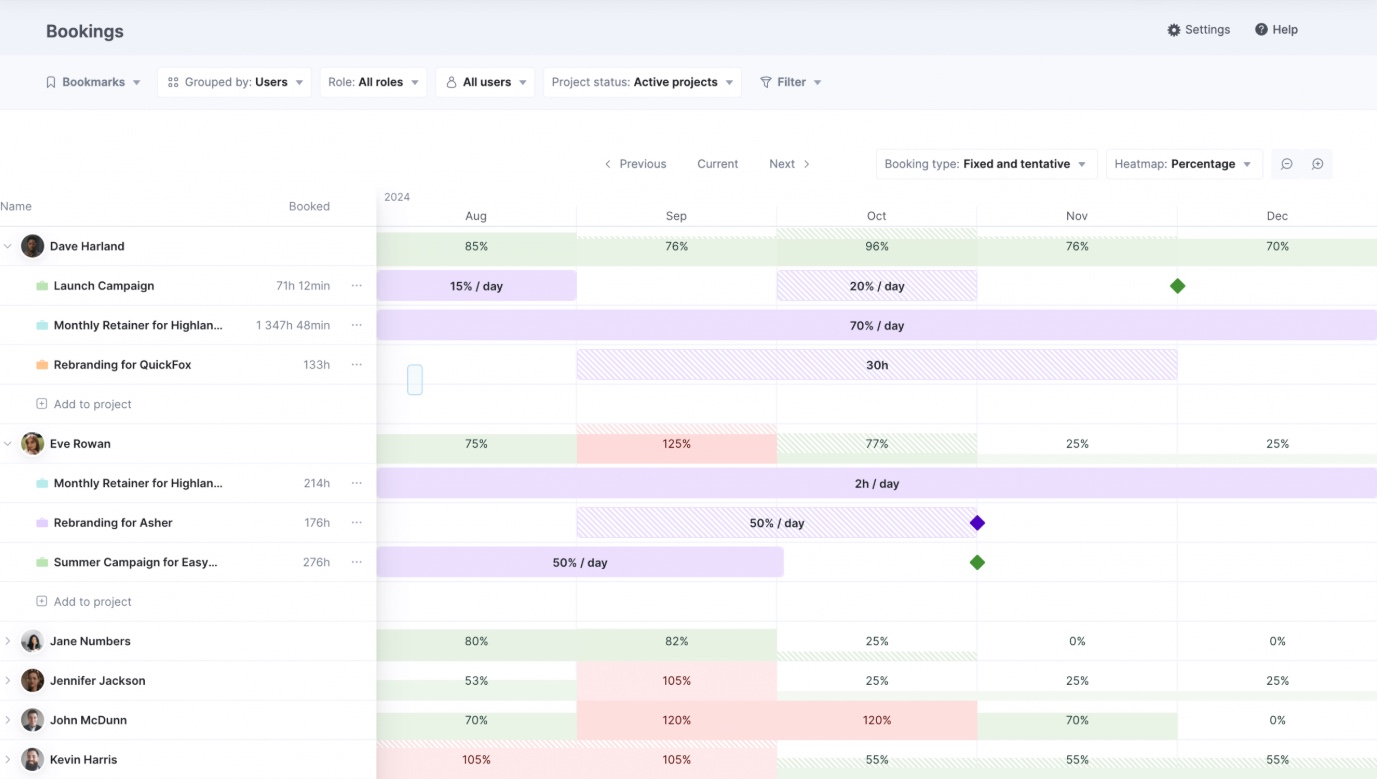If you’re wondering why your team seems busy but profit margins are flat (or even down) you might be stuck in the “productivity trap.”
This happens when companies chase work volume instead of value. And it’s one of the most common challenges in professional services firms.
We spoke with 20+ business leaders about how to redefine productivity and fix the issues holding your firm back.
Let’s dive in:
What is business productivity, really?
Productivity isn’t about how many hours your team logs. it’s about how much profit those hours generate.
As Makena Finger Zannini, founder of The Boutique COO, puts it:
Productivity isn’t just about hours logged or tasks checked off. It’s about profitable output.
This can be hard to grasp in service firms where billable hours feel like the main measure of success.
But tracking hours without considering profit gives you an incomplete picture.
Consider the differences between:
- “Our team worked 1,200 hours last month”
- “We made $87/hour from project delivery”
The first statement tells you about effort. The second tells you about results. You need both pieces—the hours and the return on those hours—to understand true productivity.
With this dual perspective, you’ll be able to make better use of your team’s time and energy. And transform busy work into truly productive, valuable work.
Why so many companies get stuck in the productivity trap
When businesses mistake motion for progress, teams stay busy “checking boxes.” But the work doesn’t translate into meaningful business outcomes.
Andrew Cussens from photography studio FilmFolk experienced this firsthand.
His team experienced a “wake-up call” when “everyone in the company hit 90%+ utilization—only for productivity to fall because we’d spent a month over-polishing internal decks for a project that needed rapid, scrappy execution.”
We celebrated jammed calendars and processed hours-long, often fruitless meetings, only to recognize that we were exhausting our team for little upside.
Several cultural and operational forces push companies into this productivity trap:
- Hustle culture: The belief that more hours always equal better results
- “Always-on” expectations: Teams feel pressure to respond instantly to clients, splitting focus and deep work time
- Lack of prioritization: Without clear priorities, teams say yes to everything and end up with packed schedules with low-value tasks
- Unrealistic utilization targets: When everyone’s booked solid, there’s zero capacity for process improvement or strategic thinking
The result?
Teams get stuck at the bottom of what we call “The Busyness Spiral.”
At the top, teams have time for strategic planning and focused work that drives results. But as calendars fill up with admin tasks and unchecked assignments, they get dragged down into the vortex.
And when people get buried under these unrealistic workloads, unsustainable issues pop up. Quality suffers, deadlines get missed, teams burn out, and profit margins get squeezed.
5 silent productivity killers to address
The biggest productivity killers in professional services aren’t always easy to spot. On the surface, they can seem part of normal business operations. But they actually create unnecessary work and drain margins.
Here are the five most common ones we see across professional services:
1. Over-servicing disguised as “great client service”
This starts innocently enough: a client asks if you can “just squeeze in” one small change. Sure, no problem.
But then, another change request comes in. And it happens again on a new project.
Before long, you’re delivering more work than you originally scoped while training clients to expect endless extras at no additional cost.
Steve Morris, founder and CEO of digital marketing agency NEWMEDIA, tracked the impact of this kind of overservicing across 130 active projects.
And those “off-the-books, just helping out” tasks made up about 15% of all delivery hours. So 15% of his team’s time generated zero revenue.
To fix it, Steve had to develop a clear process for handling these situations:
We created scripts, escalation steps, and instant prompts for when and how to push back or bring a request into a formal scope conversation. And after six months, we cut down our unbilled extra work by a third.
Follow Steve’s example:
Give your team a defined workbook on how to diplomatically address scope creep.
This way, they have the guidance and confidence they need to protect the business while still keeping clients happy.
A professional services automation (PSA) tool like Scoro can help here.
With Scoro’s “Budget health” chart, you can see in real time how extra hours are eating into your profit margin.
The teal line tracks what you agreed to bill, while the purple line shows your internal costs. If the lines start closing in, it’s a red flag that overservicing is creeping in—and you can address it before it erodes profitability.

Plus, the work-in-progress (WIP) report shows the percentage of project progress versus costs, helping you spot when you’re overdelivering:

2. Unchecked non-billable hours
Attending meetings, updating spreadsheets, messaging on Slack. These internal tasks quickly add up—and bring in zero revenue.
“Excessive meetings or internal commitments are real productivity killers,” says Paige Arnof-Fenn, founder and CEO of marketing consultancy Mavens & Moguls.
It’s impossible to get rid of all meetings.
But to make the most of them, take a page from Paige’s book and use a clear PAL framework:
- Purpose: Define what you need to accomplish
- Agenda: Share specific topics and discussion points in advance
- Time limit: Set a firm end time and stick to it
If people need to do some research or discuss something before bringing it up in front of the full group, they have time to prepare and no time is wasted around the table.
Use Scoro’s time tracking features to shine a light on where your team’s hours are really going.
By tagging internal work like “admin” or “internal meeting” separately from billable tasks, you’ll finally see how much time is being lost to non-revenue activities.
From there, Scoro’s “Work report“ breaks everything down into billable vs. non-billable time.
If internal meetings are eating up a third of your team’s capacity, it’s no longer just a hunch—you’ve got hard data to make the case for change.
In this example below, we can see internal meetings are taking up nearly a third of the team’s total available time:

3. Too many disconnected tools
Professional services firms often end up with fragmented tech stacks for one of two reasons:
- Companies are reluctant to invest in bigger platforms (relying on a blend of spreadsheets and less-expensive tools)
- They suffer from what Ryan Pearcy, founder of Digital Transformers, calls “magpie syndrome”—constantly chasing new tools without maximizing what they already have
Either way, productivity suffers. Teams lose time and focus switching between platforms, and there’s inaccurate data entry and reporting.
You end up with lots of different systems that don’t communicate and don’t deliver clear visibility into key areas of business that enable us to make decisions
Consolidate your tech stack to integrate core business functions like time tracking, project management, and financial reporting.
The fastest way to eliminate “magpie syndrome” is to simplify.
Scoro acts as a single platform that combines time tracking, project and resource management, CRM, and financial reporting. So you don’t waste hours bouncing between disconnected systems.
For example, Saentys—a multi-entity design and marketing agency—was running projects across Asana, Deltek, spreadsheets, and Xero.
Reporting took days, and data was often outdated. After consolidating into Scoro, they cut reporting prep by two days a month and gained real-time visibility across projects, resources, and financials.
The team is super happy with Scoro because it unites multiple sources of information into one platform, simplifying our work.
Learn more tips to streamline your tools in this podcast episode of “The Handbook” with Ryan and host Harv Nagra:
4. Saying “yes” to the wrong work
Pressure to fill the pipeline can tempt you to take on any project that comes your way.
And while a packed pipeline might look great, taking on bad-fit clients will hurt your profitability more than helping.
Why?
Because you end up with clients that demand more hand-holding, push back on processes, or require work outside your team’s core expertise—often while expecting lower rates.
As David Quintero, CEO of PR and marketing firm NewswireJet, says:
We’ve learned the hard way that saying ‘yes’ to everything spreads your team thin and usually leads to more overservicing, more internal stress, and honestly, less profit in the end.
Instead, create an objective scoring system to qualify prospects. Rank them in areas like:
- Strategic fit: Does this align with your long-term business goals and ideal client profile?
- Margin potential: Can you price this work profitably or will you need to drop rates to win it?
- Team capability: Do you have the right in-house skills and bandwidth or will you need to outsource?
- Scope clarity: Is the client clear about what they want or vague?
Being willing to turn down work that doesn’t align with your business strengths and goals will free up room for the work that actually moves your business forward.
Use our Client Red Flag Checklist as a quick cheatsheet to evaluate new opportunities before committing.
Scoro’s ”Project list” view shows you exactly which types of work give you the best returns.
Filter completed projects to analyze delivery margins, profits, and average billable rates across different clients and project types.
This historical project data helps you make smarter decisions about whether to accept different types of future work.

5. Running at 100% capacity (and calling it efficient)
Scoring 100% can be a great thing in other scenarios (like tests), but it’s a terrible benchmark for resource utilization.
Peter Murphy Lewis, founder and fractional CMO at Strategic Pete, explains the problem:
Agencies pride themselves on hustle. But when everyone’s calendar is slammed, there’s zero margin for strategy, reflection, or even basic optimization. You can’t fix a leaky funnel when you’re drowning in work.
The hidden costs of these overbooked schedules compound quickly:
- Burnout leads to disengaged employees and turnover
- Quality suffers because team members are rushing through work
- Process improvements get postponed indefinitely
- Client relationships deteriorate when teams can’t respond to urgent requests without derailing other projects.
Avoid this by aiming for 75-80% billable utilization instead.
As Pete notes, “Once we started capping team utilization at 80%, revenue per employee increased. Why? Because we gave space to actually think, improve, and lead clients—not just serve them.”
Give your team breathing room to produce great work and brainstorm new processes and improvements before you end up with full-blown crises.
Use Scoro’s “Bookings” heatmap for an easy way to plan work and balance capacity:
- Tentative bookings (striped background) let you block time for key roles while waiting for final approval
- Fixed bookings (solid background) lock in confirmed timelines and deliverables once the client has committed
- Color-coded capacity shows availability at a glance: green means available, red indicates overbooked, violet shows extra availability, and white means no capacity because someone is off
That way, it’s immediately obvious when someone is overloaded at more than 100% capacity. And you can quickly reschedule or redistribute tasks before burnout sets in.

Spot and fix your productivity killers
Improving business productivity involves identifying and addressing the issues that slow your team down.
Looking for more tips on how to do it? Check out our “How to Systemize Your Business: A No-Nonsense Guide.“
Or check out our customer success stories for real-world examples of how Scoro has helped thousands of teams increase their productivity.






